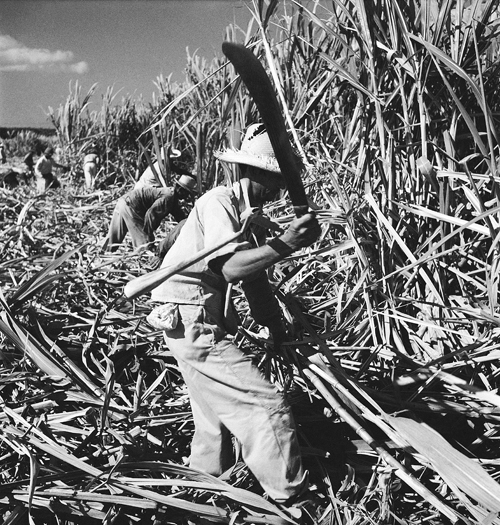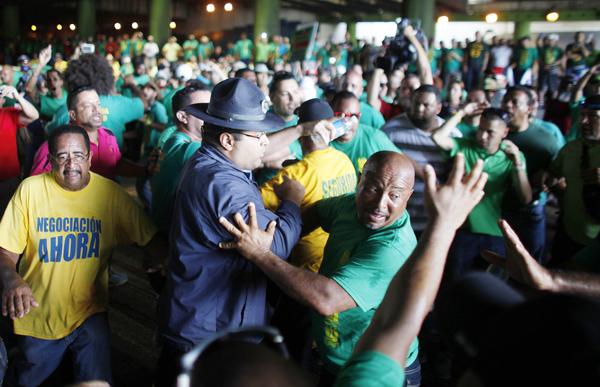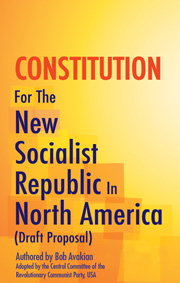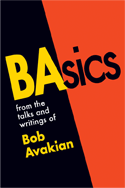A History of Super-Exploitation and Vicious Domination
Bloodsucking, Blackmail, and Bullshit: The U.S. Forces Puerto Rico to the Wall
June 20, 2016 | Revolution Newspaper | revcom.us
On July 1, the government of Puerto Rico is scheduled to make a $2 billion payment on $72 billion of debt. As the Fiscal Times wrote, there is “no way” the government will be able to make this payment.
The Puerto Rican government missed a $399 million debt payment last month, the second time it has failed to make a debt payment. Now, a much larger payment is looming.
A further default would be catastrophic for the people of Puerto Rico, who have been suffering from a decade of severe economic recession. But any agreement reached between the government of Puerto Rico and its creditors would also be catastrophic. It would undoubtedly impose further harsh cutbacks in social services, wages, Medicaid and Medicare payments, and funding for education.
Media Bullshit Turns Reality of Puerto Rico Upside Down
From the way this has been spun in U.S. media commentary, anyone unfamiliar with the situation would think the U.S. has been a benevolent, if sometimes paternalistic, benefactor of Puerto Rico, one that has allowed its people and government to spend money foolishly. According to this “narrative,” “the people of Puerto Rico have benefited from U.S. generosity that is no longer available in these difficult times, and suffered from corruption of their own officials.” Puerto Rico failed to “tighten its belt,” as the Financial Times wrote. When the FBI arrested 10 Puerto Rican officials and businessmen recently, the agent in charge said “this is one more case of graft, greed, and corruption that over the past 20 years have contributed to the government of Puerto Rico’s fragile financial condition and brought it to the brink of bankruptcy.”
All this is complete bullshit that turns reality upside down. In actual fact, U.S. imperialism has sucked the blood of the Puerto Rican people for almost 120 years. It has viciously oppressed and exploited them. The U.S. has denied the people of Puerto Rico the most basic right of national self-determination. It has wrenched enormous profit from the abundance of the land and relentless exploitation of the people who live there. And now it is striving to wring even more from the people of Puerto Rico.
A Century of Political and Cultural Suppression
In 1898, U.S. military forces invaded and occupied Puerto Rico as part of their triumph over a decaying imperial Spain in the Spanish-American War. Victory over Spain established the U.S. as the unquestioned major power in the Caribbean and much of South America. The U.S. also seized the Philippines from Spain and made it a colony, thus positioning the U.S. to contend for domination in the Pacific.
A treaty signed by the U.S. and Spain in December 1898 ended Spain’s colonial domination of Puerto Rico. Were the people of Puerto Rico given their freedom and self-determination by the U.S., that “great champion of freedom and democracy”? Hell no. They were forcibly maintained as a colony, only now under total U.S. control, and have stayed that way up to today! Over 12 decades the U.S has viciously and consistently tried to crush the desire of people in Puerto Rico to determine their own destiny.
Immediately upon seizing control, the American occupiers instructed military commanders to make sure the people obeyed U.S. authority. They sought to crush the spirit, culture, and language of the people, and continued to do so for decades.
The military declared in 1898 that using Spanish, the language of the people, in schools and other institutions was illegal. The U.S. banned the national flag of Puerto Rico and jailed anyone caught displaying it. Fifty years later, in 1948, in the face of a growing movement for independence, the U.S.-appointed governor of Puerto Rico signed a law which made it a crime to own or display a Puerto Rican flag, to sing a patriotic Puerto Rican song, to speak or write of independence, or to meet with anyone, or hold any assembly, in favor of Puerto Rican independence. This law remained in force until 1957.
Pedro Albizu Campos, who for decades courageously fought for the independence of Puerto Rico and was the spokesperson for the Puerto Rican Independence Party, was imprisoned for 26 years by the U.S. He was repeatedly tortured and brutalized by prison authorities, and died shortly after he was released from his last imprisonment.
Puerto Rico

The U.S. Navy established its U.S. Naval Forces Southern Command with bases all over occupied Puerto Rico. For decades, it used the nearby island of Vieques for military exercises, and as a testing ground for explosives. Fierce protest from people of Puerto Rico finally brought this to an end in 2003.
A Century of Super-Exploitation and Distorted Development
Puerto Rico was developed to serve the interests of U.S. capitalism-imperialism, not to meet the needs of the Puerto Rican people. U.S. imperialism subjected Puerto Rico to a distorted, lopsided development. It is as if someone installed a powerful engine in a car they were rebuilding, but let the tires remain bald, the windshield shattered, the transmission stuck in neutral.
Imperialist buyouts forced many small farmers to work on giant plantations in tobacco, coffee, and especially sugar production, which took over much of the best land on this fertile island. By 1934, 80 percent of sugar cane farming in Puerto Rico was owned by U.S. corporations. A study done at that time revealed that Puerto Rican farmers working for the U.S. sugar barons were paid, on average, 12 cents a day for themselves and every member of their family. These pittances forced many people to leave the countryside for the slums of San Juan... as well as New York, Chicago, Boston, and other cities. Many thousands of people in this era worked as super-exploited field hands in agriculture on the U.S. East Coast, then returned to Puerto Rico for the sugar harvest.
After World War II, the U.S. imposed “Operation Bootstrap” on Puerto Rico. This was a series of initiatives to develop U.S.-owned and -based industries in Puerto Rico. It mandated, among other things, that large numbers of people be forced out of rural areas and into San Juan and other cities.

A harvester hacks at sugar cane with his machete in Puerto Rico, June 1948. (AP photo)
A scholar who studied Operation Bootstrap reported, “By the summer of 1950 eighty new industrial plants were in operation and the hundredth was under construction. When the constitution of the new Commonwealth of Puerto Rico came into effect, on July 25, 1952, some 152 factories were in operation. The overwhelming majority were consumer goods industries: producers of textiles, wearing apparel, footwear, electronics equipment, electric wiring, drafting tools, artist’s brushes, fishing tackle, artificial flowers, and other plastic and metal articles assembled in Puerto Rico for sale in the Unites States. They were ‘labor intensive’ industries, for they relied more heavily on labor than on machinery to supply the value added to the raw materials which they imported from the mainland.”
“Labor intensive” means super-exploited: the capitalists forced people to work long hours, at pay well below what similar jobs would pay in the U.S., with restricted benefits and dangerous conditions—all for the “profit intensive” benefit of the exploiters. Some people got these shit jobs in the new factories. But overall, there was a decline in the number of employed people—the people of Puerto Rico mattered to the capitalists only so long as they could produce wealth and profit.
Women working out of their homes in needle trades had been the largest single source of “industrial” employment in Puerto Rico in the 1930s, ’40s, and early ’50s. Tens of thousands of women, often with assistance from their children and occasionally their husbands, toiled at 1 to 4 cents an hour producing clothing sent to the U.S. and Europe. But even this marginal existence came to an end for tens of thousands, as the capitalists developed even cheaper ways of mass producing clothing in far-flung parts of the world. The dislocation and impoverishment capitalism-imperialism inflicted on so many people in Puerto Rico compelled a large-scale out migration in the 1950s.
Beginning in the late 1960s, pharmaceutical manufacturing behemoths moved into Puerto Rico on a big scale. Companies like Eli Lilly, Johnson & Johnson, and Bristol Myers Squibb were given lucrative federal tax incentives and set up plants on the island, where, again, workers were paid less than in similar jobs in the U.S. But in the late 1990s, the U.S. began phasing out those exemptions, and they ended in 2006. Since then, employment in pharmaceutical manufacturing has shriveled, as the corporate giants searched for new people and lands to exploit.
Generation after generation, millions of Puerto Rican people have created enormous wealth for U.S. imperialism. The imperialists used this to make further profits all around the world, while impoverishing the people in Puerto Rico. Now the people are left with an economy that has been utterly devastated, the carcass of which is being sucked dry by parasitic hedge funds. And to add insult to injury—the people of Puerto Rico are called “lazy” by the very parasites who have fattened off them for 120 years!
Outline of a Crisis
Today, global “turbo capitalism” churns across the planet. It has created a worldwide environment in which capitalists restlessly and constantly seek out areas in which their investments bring the largest reward. This global situation and decisions taken by the U.S. government, under both Democrats and Republicans, have bled Puerto Rico, undermined and destabilized its economy, and brought the country and its people untold suffering.

Blocking a main entrance tunnel, to protest austerity measures in San Juan, Puerto Rico, June 2014. (AP Photo)
Now Puerto Rico is hemorrhaging people, and most of those who remain are afflicted with intensified repression and arrogant contempt by their imperialist overlords. Over the last decade, hundreds of thousands of people—out of a population of 3.5 million—have been forced to leave Puerto Rico and try to find a living in the U.S. This is the largest migration since what is known as the Great Migration during Operation Bootstrap after World War 2.
Many highly educated people, including doctors and health care professionals, have left, leaving Puerto Rico particularly vulnerable as the Zika virus spreads. Cuts in funding inflict further restrictions on health care, and a potentially calamitous crisis in public health looms. “These are a cascade of cuts that will have disastrous, gigantic implications,” said the chairman of the Puerto Rico Healthcare Crisis Coalition. “Health care in Puerto Rico is headed for a collapse.”
Official unemployment is 12 percent. In reality, as lawyer Linda Backiel wrote recently in Monthly Review, “Workforce participation hovers at 40 percent, the majority without full time jobs.” With most farmers driven from the land, close to 90 percent of the food in Puerto Rico must be imported today. This, and the fact that U.S. law requires all shipping to and from the island to use American services, means that food is particularly costly in Puerto Rico.
Utility bills in Puerto Rico average more than twice the cost that they are in the U.S. The cost of electricity is “probably the most serious issue we face today,” a business executive with investments in Puerto Rico said. Soaring utility costs impact the cost of everything, in particular the ability of basic people to survive and obtain lighting, transportation, water, and other life necessities. A woman in San Juan said her community does not have even a basic sewage system. When it rains, water flows into a canal and wastewater backflows into the pipes carrying drinking water, and even floods into their homes. “What keeps impacting us is the problem of polluted water ... our children have to put their feet in polluted water....”
Most children in Puerto Rico now live in poverty, and 84 percent of them grow up in impoverished communities. Children are suffering even more than the rest of the population because of soaring costs, cutbacks in funding for schools and public health, and steep reduction of all government services. Dozens of schools have been closed; deep funding slashes have crippled public higher education. Mass criminalization and incarceration of generations of youth has been carried out systematically by the authorities. Linda Backiel described this situation: “One hundred twenty-five residents of a single barrio or housing project may be charged in a single federal drug conspiracy indictment, so that three generations end up in jail, essentially for participating in the only economic activity visible in their community.”
 The Constitution for the New Socialist Republic in North America (Draft Proposal) from the RCP is written with the future in mind. It is intended to set forth a basic model, and fundamental principles and guidelines, for the nature and functioning of a vastly different society and government than now exists: the New Socialist Republic in North America, a socialist state which would embody, institutionalize and promote radically different relations and values among people; a socialist state whose final and fundamental aim would be to achieve, together with the revolutionary struggle throughout the world, the emancipation of humanity as a whole and the opening of a whole new epoch in human history–communism–with the final abolition of all exploitative and oppressive relations among human beings and the destructive antagonistic conflicts to which these relations give rise.
The Constitution for the New Socialist Republic in North America (Draft Proposal) from the RCP is written with the future in mind. It is intended to set forth a basic model, and fundamental principles and guidelines, for the nature and functioning of a vastly different society and government than now exists: the New Socialist Republic in North America, a socialist state which would embody, institutionalize and promote radically different relations and values among people; a socialist state whose final and fundamental aim would be to achieve, together with the revolutionary struggle throughout the world, the emancipation of humanity as a whole and the opening of a whole new epoch in human history–communism–with the final abolition of all exploitative and oppressive relations among human beings and the destructive antagonistic conflicts to which these relations give rise.
Read the entire Constitution For The New Socialist Republic In North America (Draft Proposal) from the RCP at revcom.us/rcp.
Ending the Nightmare of Oppression
This nightmare of exploitation and oppression will finally end when the imperialist chains that shackle Puerto Rico are shattered through revolutionary struggle. There is a proud history of resistance of the Puerto Rican people—on the island and in this country. One of the high points in this struggle was the courageous and bold struggles in the 1960s by the Young Lords Party within the U.S. This fighting spirit and struggle needs to be revived, and taken much further—into a fight for revolution based on Bob Avakian’s new synthesis of communism.
Right now is one of those rare times when the media and politicians in the U.S. are actually talking about Puerto Rico—and the real truth about Puerto Rico and the possibilities for great advance in overcoming oppression in today’s situation must be made known as widely as possible in all society. On this scientific basis, support for the struggle of the Puerto Rican people to break the imperialist chains must be built as a part of building the movement for revolution—and with the seizure of power the hold of the U.S. on Puerto Rico will be broken.
Article II, Section 3 of the Constitution for the New Socialist Republic in North America explains how the future socialist society will view and relate to the nation of Puerto Rico:
The Nation of Puerto Rico and Puerto Ricans Within the New Socialist Republic in North America.
1. Puerto Rico and its people were subjected to brutal conquest and domination—first by the Spanish Conquistadors and then by U.S. imperialism, forcibly seizing Puerto Rico at the end of the 19th century—with devastating and even genocidal consequences for the first inhabitants of the island and then the enslaving exploitation of others. Through this process, however, a Puerto Rican nation was forged on that island territory, even as Puerto Rico itself continued to be held as a colonial possession of the imperialist United States of America. As a result of the revolution which brought into being the New Socialist Republic in North America, the hold of U.S. imperialism over Puerto Rico has been broken, and the New Socialist Republic in North America recognizes the independence and right of self-determination of the nation of Puerto Rico. At the same time, the New Socialist Republic in North America works to develop relations with the nation of Puerto Rico on the basis of the internationalist orientation and other principles and objectives set forth in this Constitution, and remains open to the possibility of a union with the nation of Puerto Rico, in a larger socialist state, on this basis.
2. With regard to Puerto Ricans within the territory of the New Socialist Republic in North America, the principles and policies that apply to minority nationalities which were oppressed and discriminated against in the imperialist USA shall be applied, including the right to the establishment of autonomous areas in cities and other places where there are significant numbers of Puerto Ricans.
Volunteers Needed... for revcom.us and Revolution
If you like this article, subscribe, donate to and sustain Revolution newspaper.








